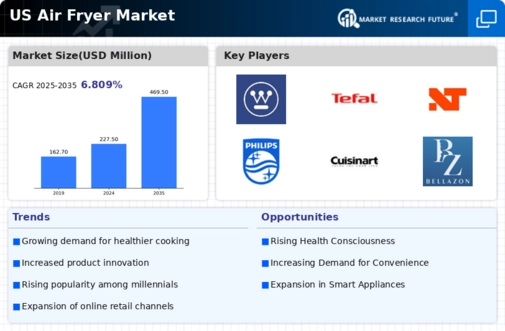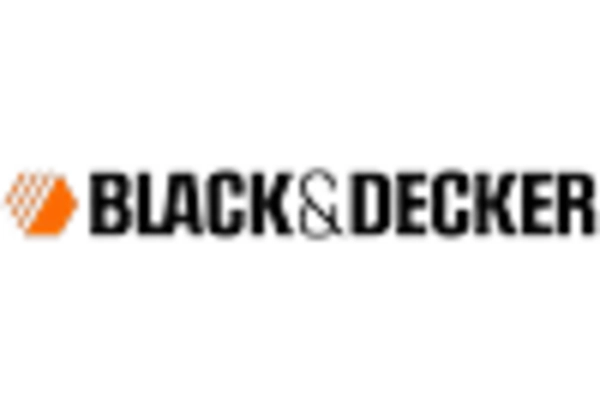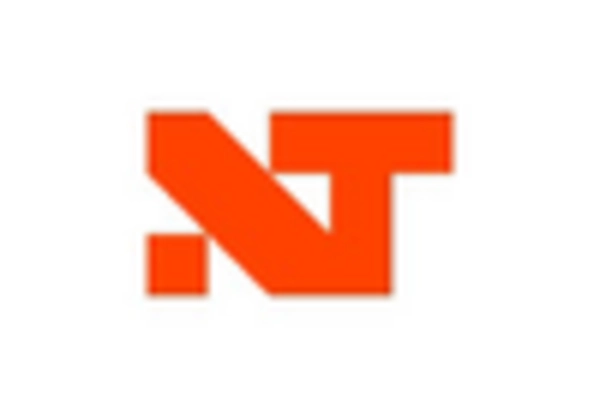Innovative Product Features
The air fryer market is witnessing a wave of innovation as manufacturers introduce advanced features to enhance user experience. Modern air fryers now come equipped with smart technology, such as app connectivity and programmable settings, allowing users to control cooking remotely. Additionally, features like multi-cooking functions and self-cleaning capabilities are becoming increasingly common. This innovation is crucial in attracting tech-savvy consumers who seek appliances that integrate seamlessly into their smart homes. According to recent data, approximately 40% of consumers in the US express interest in purchasing kitchen appliances with smart features. As manufacturers continue to innovate, the air fryer market is likely to expand, appealing to a broader audience that values both functionality and modern technology in their cooking appliances.
Convenience and Time Efficiency
The air fryer market is significantly influenced by the demand for convenience and time efficiency in meal preparation. As lifestyles become increasingly fast-paced, consumers are seeking kitchen appliances that simplify cooking processes. Air fryers offer a quick and efficient way to prepare meals, often reducing cooking times by up to 30% compared to traditional methods. This efficiency appeals particularly to busy families and working professionals who value time-saving solutions. Moreover, the air fryer market is benefiting from the trend of meal prepping, where consumers prepare meals in advance to save time during the week. The ease of use and versatility of air fryers, which can bake, roast, and fry, further enhances their appeal. Consequently, the air fryer market is likely to see sustained growth as more consumers recognize the benefits of convenience in their cooking routines.
Growing Popularity of Home Cooking
The air fryer market is benefiting from the rising trend of home cooking, which has gained traction among consumers seeking to enhance their culinary skills. This trend is partly fueled by the desire for healthier eating and the enjoyment of preparing meals from scratch. In the US, surveys indicate that nearly 60% of households are cooking more at home than they did previously, leading to increased interest in versatile kitchen appliances like air fryers. These devices allow for a variety of cooking methods, making them ideal for experimenting with new recipes. Furthermore, the air fryer market is likely to see growth as consumers share their cooking experiences on social media platforms, inspiring others to explore home cooking. This cultural shift towards home-cooked meals is expected to sustain the demand for air fryers in the coming years.
Sustainability and Energy Efficiency
The air fryer market is increasingly influenced by consumer preferences for sustainability and energy efficiency. As environmental concerns grow, consumers are becoming more conscious of the energy consumption of their kitchen appliances. Air fryers are often marketed as energy-efficient alternatives to traditional ovens and deep fryers, using significantly less energy to operate. This aspect appeals to eco-conscious consumers who are looking to reduce their carbon footprint. Additionally, the air fryer market is likely to benefit from the trend of reducing food waste, as these appliances can cook smaller portions effectively, minimizing leftovers. With energy costs on the rise, the appeal of energy-efficient cooking solutions is expected to drive further growth in the air fryer market, aligning with broader sustainability goals.
Rising Demand for Healthy Cooking Solutions
The air fryer market is experiencing a notable surge in demand as consumers increasingly prioritize healthier cooking methods. This trend is driven by a growing awareness of the health risks associated with traditional frying methods, which often involve excessive oil and fat. In the US, the air fryer market is projected to grow at a CAGR of approximately 25% from 2023 to 2028, indicating a robust shift towards healthier alternatives. Consumers are seeking appliances that allow them to prepare meals with less oil while retaining flavor and texture. This shift is further supported by the increasing availability of air fryer recipes and cooking shows that promote air frying as a viable cooking method. As a result, the air fryer market is likely to continue expanding, catering to health-conscious consumers looking for convenient and nutritious cooking solutions.

















Leave a Comment